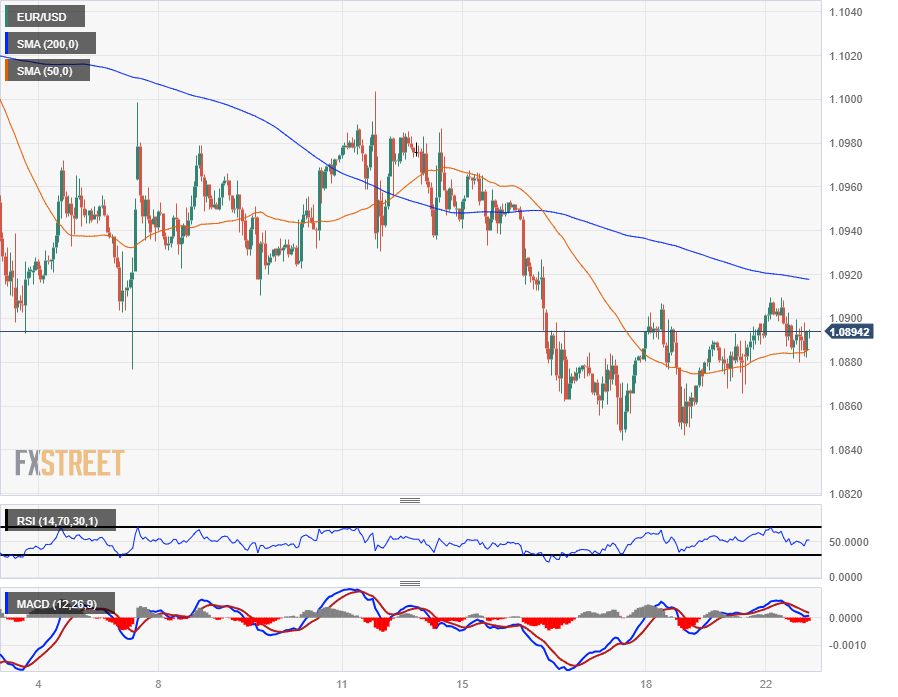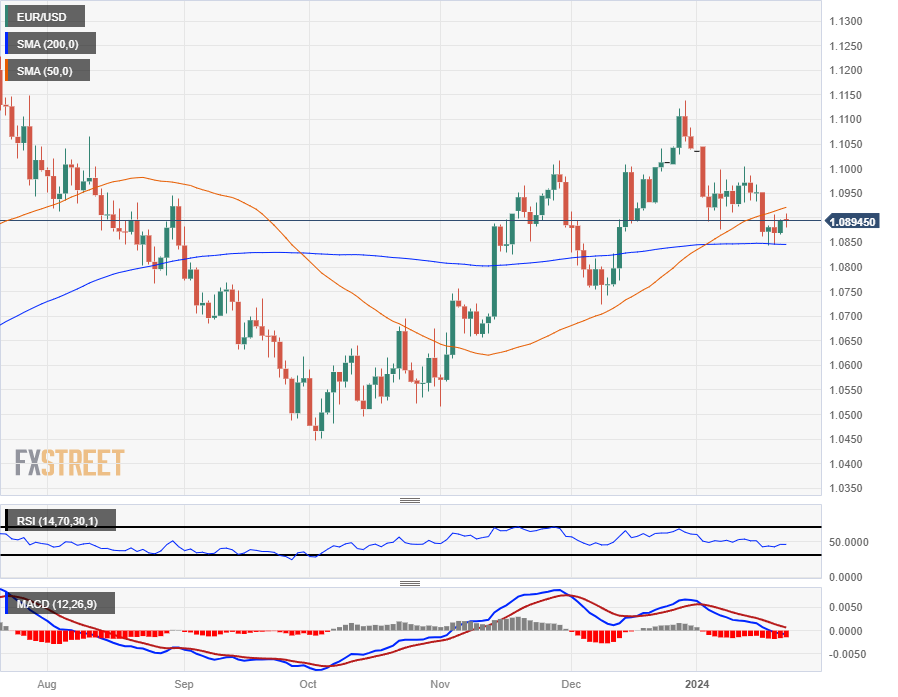- EUR/USD remains harassed by the 1.0900 level in the short term.
- Important data coming: European inflation and ECB rate decision.
- The ECB's January EU consumer confidence and bank lending survey will be published on Tuesday.
The EUR/USD pair moves on Monday, as traders take the opportunity to replenish their strength ahead of this week's hectic schedule from multiple central banks around the world.
In Europe, the European Central Bank (ECB) Bank Lending Survey and preliminary data for January on Consumer Confidence will be published on Tuesday. A new round of Eurozone Purchasing Managers' Index (PMI) figures will be released on Wednesday, and investors will prepare for a new rate call from the ECB on Thursday.
Daily Market Summary: EUR/USD Remains Near 1.0900 After Trimming Gains Last Week
- A quiet Monday will give way to a busy weekend, in which the ECB's decision on interest rates will be the protagonist.
- Market expectations for rate cuts in 2024 have been well ahead of what policymakers could or would be willing to deliver.
- The ECB is firmly committed to keeping rates on hold until the summer at the earliest, barring significant changes in economic data.
- On Tuesday, Eurozone consumer confidence is expected to rebound in January from -15.0 to -14.3 points.
- The EU HCOB Composite PMI will rebound slightly in January, from 47.6 to 48.0 points.
- Germany's HCOB Composite PMI is also expected to rise from 47.4 to 47.8 in January.
- With the functional guarantee that the ECB will maintain its main reference rate at 4.5% on Thursday, investors will be closely monitoring the ECB's subsequent monetary policy statement.
Euro quote today
The following table shows the percentage change of the euro (EUR) against the main currencies quoted today. The euro was the strongest currency against the New Zealand dollar.
| USD | EUR | GBP | CAD | AUD | JPY | NZD | CHF | |
| USD | -0.04% | -0.23% | 0.14% | 0.15% | -0.13% | 0.27% | -0.05% | |
| EUR | 0.06% | -0.18% | 0.20% | 0.20% | -0.07% | 0.32% | 0.01% | |
| GBP | 0.24% | 0.19% | 0.38% | 0.39% | 0.12% | 0.51% | 0.20% | |
| CAD | -0.14% | -0.17% | -0.38% | 0.02% | -0.26% | 0.15% | -0.18% | |
| AUD | -0.15% | -0.19% | -0.39% | 0.00% | -0.27% | 0.13% | -0.18% | |
| JPY | 0.12% | 0.06% | -0.08% | 0.26% | 0.28% | 0.42% | 0.09% | |
| NZD | -0.27% | -0.33% | -0.52% | -0.13% | -0.13% | -0.41% | -0.32% | |
| CHF | 0.03% | -0.01% | -0.20% | 0.18% | 0.18% | -0.10% | 0.30% |
The heat map shows the percentage changes of the major currencies against each other. The base currency is chosen in the left column, while the quote currency is chosen in the top row. For example, if you choose the euro in the left column and scroll down the horizontal line to the Japanese yen, the percentage change that appears in the box will represent EUR (base)/JPY (quote).
Technical Outlook: EUR/USD Still Stuck in Consolidation as Markets Await Midweek
The EUR/USD pair continues to trade in a technical mid-range between the major moving averages as markets reach an unstable balance between rate expectations and economic outlook between the Euro (EUR) and the US Dollar (USD).
Intraday action continues to squeeze in the chart space near 1.0900, capped by the 200-hour SMA near 1.0920, and the Euro loses 1.3% against the US Dollar in 2024. Despite the recent decline, EUR/USD is stubbornly clinging to recent technical levels.
Daily candles see EUR/USD drifting within the chart paper between the 50-day and 200-day SMAs at 1.0921 and 1.0845 respectively. The pair's long-term momentum remains bullish as higher lows continue to rise, but gains from the top are starting to taper off and the 1.1000 zone is starting to form a tough technical resistance barrier.
EUR/USD Hourly Chart

EUR/USD Daily Chart

Frequently asked questions about the euro
What is the euro?
The Euro is the currency of the 20 countries of the European Union that belong to the Eurozone. It is the second most traded currency in the world, behind the US dollar. In 2022, it accounted for 31% of all foreign exchange transactions, with an average daily volume of more than $2.2 trillion per day.
EUR/USD is the most traded currency pair in the world, accounting for an estimated 30% of all transactions, followed by EUR/JPY (4%), EUR/GBP (3%) and EUR/AUD (2% ).
What is the ECB and how does it influence the euro?
The European Central Bank (ECB), headquartered in Frankfurt, Germany, is the reserve bank of the euro zone. The ECB sets interest rates and manages monetary policy.
The ECB's main mandate is to maintain price stability, which means controlling inflation or stimulating growth. Its main instrument is to raise or lower interest rates. Relatively high interest rates – or the expectation of higher rates – tend to benefit the euro and vice versa.
The Governing Council of the ECB takes monetary policy decisions at meetings held eight times a year. Decisions are made by the heads of the eurozone's national banks and six permanent members, including ECB President Christine Lagarde.
How do inflation data influence the value of the euro?
Eurozone inflation data, measured by the Harmonized Index of Consumer Prices (HICP), is an important econometric data for the euro. If inflation rises more than expected, especially if it exceeds the 2% target set by the ECB, it is forced to raise interest rates to bring it back under control.
Relatively high interest rates compared to their peers tend to benefit the euro, making the region more attractive as a place for global investors to park their money.
How do economic data influence the value of the euro?
Data releases measure the health of the economy and can influence the euro. Indicators such as GDP, manufacturing and services PMIs, employment and consumer sentiment surveys can influence the direction of the single currency.
A strong economy is good for the euro. Not only does it attract more foreign investment, but it may encourage the ECB to raise interest rates, which will directly strengthen the euro. Conversely, if economic data is weak, the euro is likely to fall.
The economic data for the four largest economies in the eurozone (Germany, France, Italy and Spain) are especially significant, as they represent 75% of the eurozone economy.
How does the Trade Balance affect the euro?
Another important publication for the euro is the Trade Balance. This indicator measures the difference between what a country earns from its exports and what it spends on imports during a given period.
If a country produces highly sought-after export products, its currency will appreciate due to the additional demand created by foreign buyers wishing to purchase these goods. Therefore, a positive Net Trade Balance strengthens a currency and vice versa for a negative balance.
Source: Fx Street
I am Joshua Winder, a senior-level journalist and editor at World Stock Market. I specialize in covering news related to the stock market and economic trends. With more than 8 years of experience in this field, I have become an expert in financial reporting.







